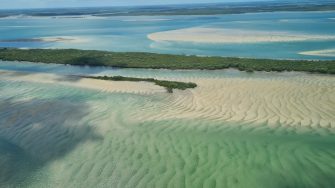
Date: Thursday, November 18, 2021
Project: Eastern Australian Waterbird Survey
Observers: John Porter & Richard Kingsford
Pilot: Tim Dugan
Today was a big day, one that we didn't think we would ever make. On Thursday we got the green light for entry into Queensland, as specialist workers. So we were off up the coast, following our usual path, but more than a month out. We usually try and do this leg in early October to avoid the heat of Queensland. Obviously this year and last year were quite different and our usual timing was inevitably awry. But great to get it done.
We surveyed the eastern edges of survey bands five to eight today. We were aiming to reach Gladstone, further than we usually go to make up some time. First on our list was Myall Lakes, which as usual had relatively few waterbirds.
Myall Lakes are extensive brackish lakes with hardly any waterbirds.
Surveying Myall Lakes.
The clear water of Myall Lakes produces some stunning colours, with sand bars undereneath.
There were even fewer black swans and cormorants then we usually see on the lakes. This is mainly because there is so much more water inland this year, compared to other recent years. From here we flew up to the next survey band 5, which runs predominantly along the Bellinger River and its associated wetlands. Again, there were no more than a couple of pelicans, silver gulls and some large waders.
Surveying the wetlands of the Bellinger River, near the town of Urunga.
Survey band 6 was equally depauperate in waterbirds at this end of it, near the coast. It is just north of Byron Bay. We surveyed a few dams around here and some of the coastal streams, with no more than a handful of waterbirds. Then we headed for Maroochydore in Queensland to refuel.
We took the coastal route, past the Gold Coast.
And Stradbroke Island.
Instead of staying as we usually do at Maroochydore, we planned to just refuel here and get our required Covid Test. We’re running on a daily schedule of covid tests because we had to get one before leaving NSW, the day before. All part of our health requirements and a small price to pay to ensure we get the 39th aerial survey done.
We surveyed some large dams, just inland of Maroochydore.
Then it was back to the coast to survey Lake Weyba.
None of these wetlands had many waterbirds. From here it was past Noosa, Fraser island and Hervey Bay on our way to Survey Band 7.
Mouth of the Noosa River.
Hervey Bay.
The next survey band 7 is around Baffle Creek. Here there are increasing numbers of prawn farms and farm dams each year.
Surveying one of the prawn farms. Even though there is a lot of water, no waterbirds, probably for the obvious reasons that they have ways of keeping them away.
Surveying down the middle of Baffle Creek.
There were a few more migratory wading birds on the creek than we've seen in the past.
Surveying one of the northern coastal creeks and its estuary.
And then it was on to Gladstone for the night. One day of survey down in Queensland.
By Richard Kingsford
